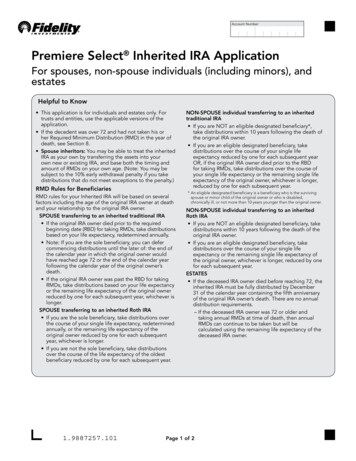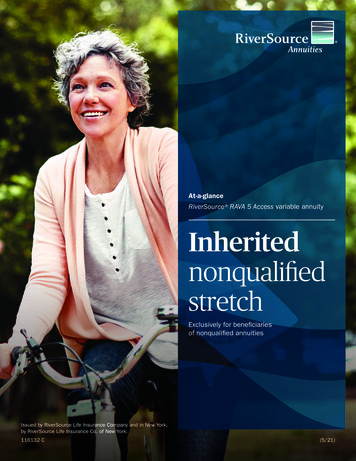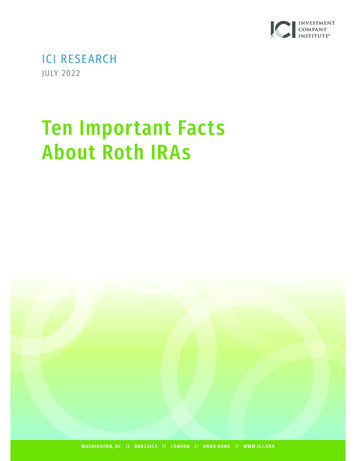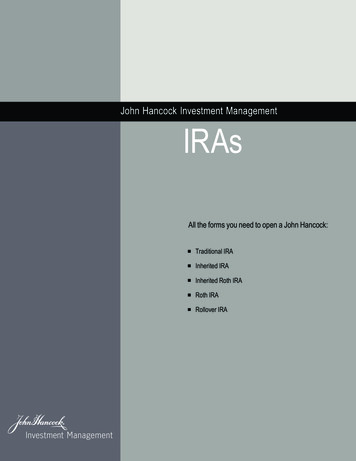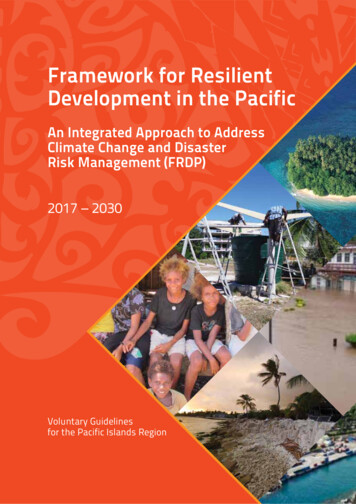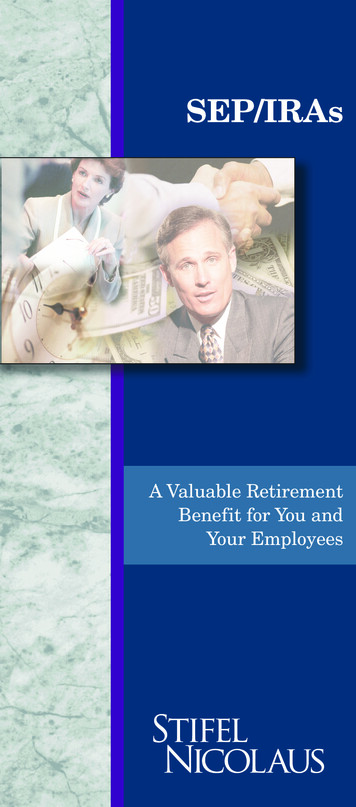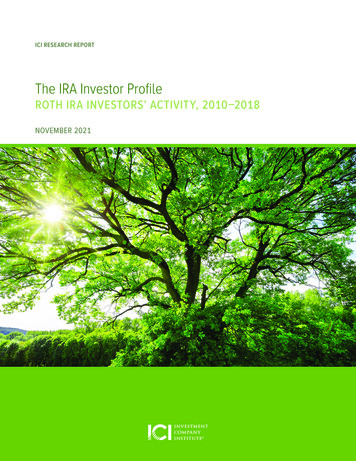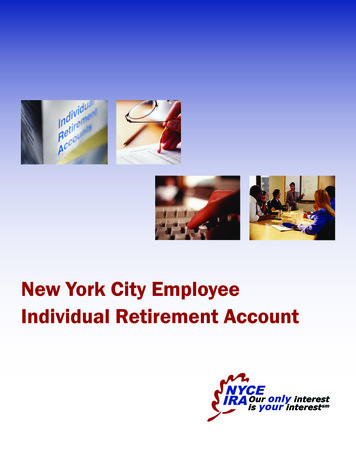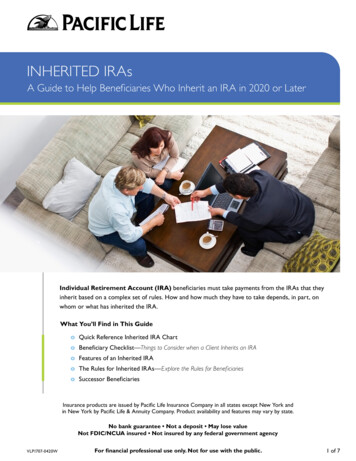
Transcription
INHERITED IRAsA Guide to Help Beneficiaries Who Inherit an IRA in 2020 or LaterIndividual Retirement Account (IRA) beneficiaries must take payments from the IRAs that theyinherit based on a complex set of rules. How and how much they have to take depends, in part, onwhom or what has inherited the IRA.What You’ll Find in This Guideo Quick Reference Inherited IRA Charto Beneficiary Checklist—Things to Consider when a Client Inherits an IRAo Features of an Inherited IRAo The Rules for Inherited IRAs—Explore the Rules for Beneficiarieso Successor BeneficiariesInsurance products are issued by Pacific Life Insurance Company in all states except New York andin New York by Pacific Life & Annuity Company. Product availability and features may vary by state.No bank guarantee Not a deposit May lose valueNot FDIC/NCUA insured Not insured by any federal government agencyVLP1707-0420WFor financial professional use only. Not for use with the public.1 of 7
Quick Reference Inherited IRA ChartEDBEligible Designated BeneficiaryDBDesignated BeneficiaryNon- DBNon-designated BeneficiaryLELife IONSOwner’ssurvivingspouseRolloverRemain asbeneficiary*DBsOwner’sminor childLifeexpectancyuntil age 18Non-DB**or EntityOtherEDBsThen10 yearsLifeexpectancy10 years5 yearsDeceasedowner’s“ghost” LE*There are two scenarios when a surviving spouse may decide to postpone rolling over some or all of the inherited IRA to his or her own IRA:1. T o avoid the 10% early distribution penalty as an IRA owner, a surviving spouse who is younger than age 59½ may wish to remain abeneficiary on some or all of the inherited IRA until he or she reaches that age.2. T o avoid RMDs as an IRA owner, a surviving spouse who is near the RMD distribution age and has inherited an IRA from a youngerspouse may wish to remain a beneficiary on some or all of the inherited IRA until the younger spouse would have reached age 72.**For non-designated beneficiaries or entities, the five-year rule applies when the IRA owner dies before his or her required beginningdate (RBD). Alternatively, the deceased IRA owner’s “ghost” life expectancy becomes the distribution rule when the IRA owner dies onor after his or her RBD.For financial professional use only. Not for use with the public.2 of 7
Types of BeneficiariesThe rules define three types of beneficiaries: eligible designated beneficiaries (EDBs), designated beneficiaries(DBs), and non-designated beneficiaries or entities (non-DBs).EDBsDBsEntitiesSpousesNon-spousal individualsCharitiesDisabled or chronically illCertain trustsEstatesNot more than 10 years youngerCertain trustsMinor childrenCertain “see-through” trustsA beneficiary’s status as an EDB is determined at the time of the IRA owner’s death.A beneficiary’s status as a DB is determined on 9/30 of the year following the year of the IRA owner’s death.Beneficiary ChecklistHere are some items that beneficiaries may wish to consider when inheriting an IRA.o Last Required Minimum Distribution (RMD) D etermine if the IRA owner’s year of death RMD, if any, was taken. If not, take it by 12/31 of that year toavoid a 50% penalty.o EDBs (Except Surviving Spouses and Minor Children) C onsider taking RMDs based on life expectancy to minimize income taxes due on IRA distributions or tomaximize tax-free growth on the inherited Roth IRA account balance.o Surviving Spouses Consider special planning opportunities, including:–B ecoming the owner of some or all of the account by rolling it over to his or her own traditional orRoth IRA or retirement plan at work.– I f younger than age 59½, remaining the beneficiary of some or all of the account to avoid the 10%penalty on early distributions. At age 59½, a rollover of any remaining balance is still possible.– I f age 72 or older and inheriting from a spouse who died younger than age 72, remaining thebeneficiary of some or all of the account to avoid (at least temporarily) RMDs on the inherited IRA.A surviving spouse is not required to take payments from an inherited IRA until 12/31 of the yearthat the deceased IRA owner would have reached age 72.– I f some or all of the account is not needed, disclaiming the amount not needed so that the contingentbeneficiaries can inherit. When the contingent beneficiaries are adult children, inheriting IRAs fromeach parent at different times provides them with two different 10-year payout periods and, perhaps,a longer distribution time frame should the surviving spouse live considerably longer.For financial professional use only. Not for use with the public.3 of 7
o Minor Children B e prepared to switch from life expectancy payments to the 10-year payout at age 18. Also, beware of theKiddie Tax, where unearned income, including inherited IRAs, above an annual threshold is taxed at theparents’ rather the child’s tax rates.o Adult Children, Grandchildren, and Other Designated Beneficiaries P lan your distributions according to the 10-year payout, whereby the entire inherited IRA must bedistributed by 12/31 of the year that has the tenth-year anniversary of the IRA owner’s death. Scheduledistributions during this 10-year period in a tax-efficient manner based on current and projected futureincome and tax rates.o Any Original Beneficiary Name a successor beneficiary for the inherited IRA to avoid the possibility that the estate is named by default. Review the inherited investments and align them based on risk tolerance.Features of an Inherited IRAConsolidationIf a client inherits several different retirement accounts or IRAs from the same decedent, it might make sense toconsolidate all the inherited assets. Leaving assets in multiple inherited retirement accounts increases paperwork,recordkeeping responsibility, and possibly expenses.Tax AdvantagesBeneficiaries are generally required to pay income tax on the distributions they receive from their inherited IRAs.Whatever is not required and not taken remains tax-deferred or, with a Roth IRA, tax-free. Failure to take therequired amount results in a penalty of 50% of what should have been taken. Managing the income taxconsequences may mean taking smaller payments over a longer period of time or taking payments over a number,and in different, years.FlexibilityAlthough most beneficiaries are not required to take minimum distributions each year, he or she always has theability to take a distribution, and the additional 10% federal tax for distributions taken prior to age 59 ½ will notapply since the distributions are the result of death.The Rules for Inherited IRAsDistribution MethodsInherited IRAs are distributed over a fixed period or over a life expectancy, depending on who or what is thebeneficiary of the IRA.EntitiesFive-year/deceased IRA owner’s “ghost” life expectancyDBsTen-yearEDBsLife expectancyMinor childLife expectancy until age 18, then 10-yearFor financial professional use only. Not for use with the public.4 of 7
Fixed PeriodFixed period distributions require that an inherited IRA be distributed by 12/31 of the year that contains eitherthe fifth- or tenth-year anniversary of the IRA owner’s death.Entities must use the five-year payout when the IRA owner dies before his or her required beginning date (RBD).An IRA owner’s RBD is April 1 of the year after he or she reaches age 72.1DBs must use the 10-year payout regardless of when the IRA owner’s death occurs (before, on, or after his or her RBD).With either the five- or 10-year payout, no annual payments are required. There is only one required payment,which is the account balance on 12/31 of the deadline year. The clock begins in the year following the year the IRAowner dies, giving the beneficiary either six or 11 years over which to take payments.Year ofDeathFive-Year0Ten-Year510Period Certain PayoutLife ExpectancyLife expectancy payouts require annual minimum payments. These RMDs are determined by dividing the previousyear’s account balance on 12/31 by a life expectancy factor.212/31 account balance single life expectancy factor RMDEDBs may use the life expectancy payout regardless of when the IRA owner dies.Most often, the life expectancy factor is based on the EDB’s attained age in the year following the year the IRAowner died. The factor for all EDBs (except surviving spouses) is fixed, meaning that it is reduced by one everyyear after the first required distribution year. The factor for surviving spouses is recalculated, meaning that it istaken annually from the IRS table and, as a result, is reduced by less than one. Also, once a minor child reachesage 18, the life expectancy payout for the minor child switches to the 10-year payout, so that the inherited IRAmust be distributed to that child in the year that he or she reaches age 28.31 For individuals born after June 30, 1949. Roth IRAs do not currently have an RBD for their owners.IRS Table I (Single Life Expectancy).2 In a recent announcement, the IRS seems to have taken the position that the age of majority for minor children is age 18 without regardto state law differences.3 For financial professional use only. Not for use with the public.5 of 7
When the IRA owner dies on or after his or her RBD, and the beneficiary is either an entity or an EDB who isolder than the IRA owner, then the deceased IRA owner’s “ghost” life expectancy may be used. This “ghost” lifeexpectancy is based on the IRA owner’s attained age in the year of his or her death, reduced by one for each ofthe following years.Successor BeneficiariesAn original beneficiary of an inherited IRA should name a successor beneficiary in the event he or she dies beforethe inherited IRA is fully distributed. If the original beneficiary is an EDB1 and is using the life expectancy payout,then the successor beneficiary, no matter who or what, must switch to the 10-year payout. If the original beneficiaryis a DB and is using the 10-year payout, then the successor beneficiary, no matter who or what, must distribute thebalance of the account within the original 10-year payout (that is, by 12/31 of the year that has the tenth-yearanniversary of the IRA owner’s death).1 There is a special rule for a surviving spouse who dies with an inherited IRA before the deceased IRA owner would have reached age 72.For financial professional use only. Not for use with the public6 of 7
For additional information about inherited IRAs,contact the Retirement Strategies Group at(800) 722-2333, ext. 3939 or RSG@PacificLife.comPacificLife.comThis material is provided for informational purposes only and should not be construed as investment, tax, or legal advice.Information is based on current laws, which are subject to change at any time. Clients should consult with their accounting or taxprofessionals for guidance regarding their specific financial situations.For financial professional use only. Not for use with the public.VLP1707-0420W7 of 7
Insurance products are issued by Pacific Life Insurance Company in all states except New York and in New York by Pacific Life & Annuity Company. Product availability and features may vary by state. . Entities Five-year/deceased IRA owner's "ghost" life expectancy DBs Ten-year EDBs Life expectancy Minor child Life expectancy until age 18 .
